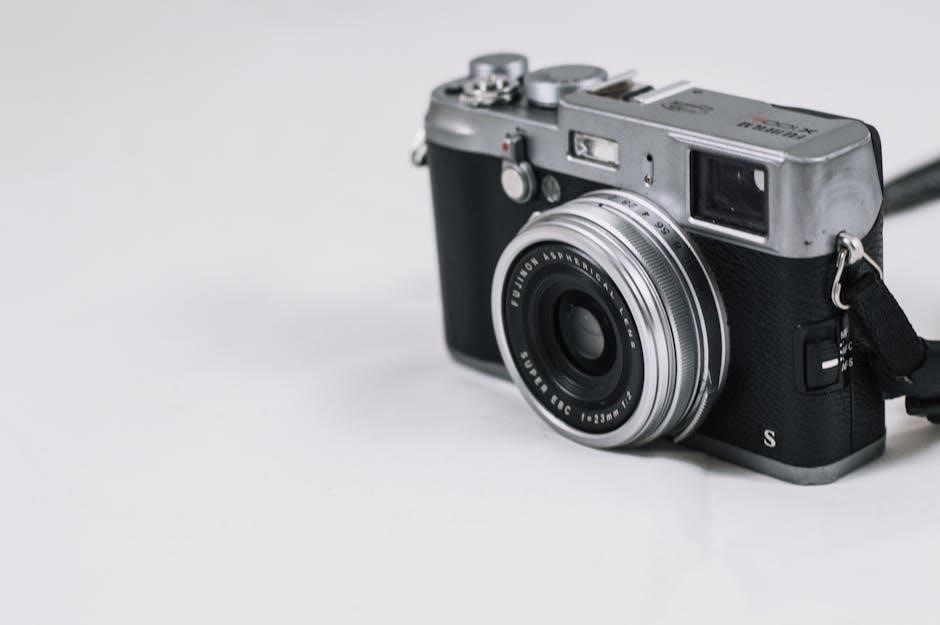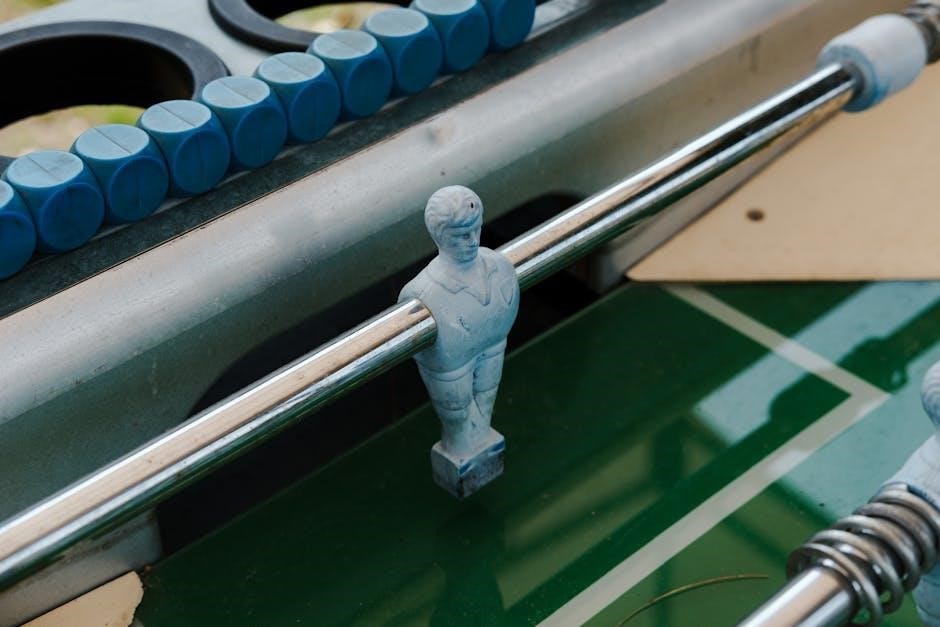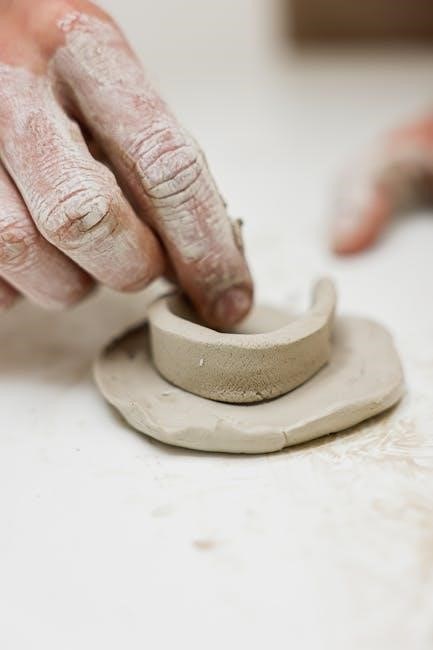Welcome to the LightBurn manual! This guide provides a comprehensive overview of LightBurn software, covering its features, best practices, and troubleshooting tips for optimal laser operations.
Overview of LightBurn Software
LightBurn is a professional-grade laser engraving and cutting software designed to work with a variety of laser machines. It offers a user-friendly interface for creating, editing, and optimizing designs. The software supports multiple file formats, including SVG, DXF, and PNG, making it versatile for different projects. LightBurn is compatible with popular laser controllers like GRBL and DSP, ensuring seamless connectivity. Its robust tools enable precise control over laser settings, such as power, speed, and frequency. With features like vector editing, raster image management, and layer control, LightBurn is ideal for hobbyists and professionals alike. Regular updates and an active community provide extensive support and resources.
Purpose and Scope of the Manual
This manual is designed to guide users through the effective use of LightBurn software, covering essential features, tools, and best practices. Its purpose is to help users understand and utilize LightBurn for laser engraving and cutting projects. The scope includes setup, design tools, and laser configuration, ensuring a comprehensive understanding of the software. Whether you’re a beginner or an experienced user, this manual provides step-by-step instructions and practical examples to optimize your workflow. It also addresses troubleshooting and safety guidelines, making it an invaluable resource for anyone working with LightBurn. By following this guide, users can unlock the full potential of their laser machines efficiently and safely.

Installation and Setup
This section guides you through the installation of LightBurn software, including downloading from the official website, running the installer, and completing initial setup and configuration.
System Requirements for LightBurn
To ensure smooth operation, LightBurn requires a computer meeting specific criteria. It supports Windows (7 or later), macOS (10.12 or newer), and Linux (64-bit). A multi-core processor, at least 4GB of RAM (8GB recommended), and a dedicated graphics card are essential. Additionally, a minimum of 500MB disk space is needed for installation. Ensure your system has a compatible laser device and an internet connection for software updates. For optimal performance, verify these requirements before installation to avoid compatibility issues and ensure all features function as intended.
Downloading and Installing LightBurn
To download LightBurn, visit the official website and select the appropriate version for your operating system (Windows, macOS, or Linux). Once downloaded, run the installer and follow the on-screen instructions to select your language and installation location. Ensure your system meets the minimum requirements before proceeding. After installation, launch LightBurn to begin setting up your laser engraving projects. For detailed steps, refer to the official documentation or tutorials available online. Always download from trusted sources to ensure software security and functionality.
Initial Setup and Configuration
After installing LightBurn, launch the software and follow the initial setup wizard. Select your laser type or choose “Manual Configuration” if your device isn’t listed. Configure basic settings like origin point, safe boundaries, and laser head offset. Define material settings and test fire your laser to ensure proper functionality. Refer to your laser’s documentation for specific configuration details. Once setup, explore the interface and customize tools to suit your workflow. For troubleshooting, visit the official LightBurn documentation or community forums for detailed guides and user support.

LightBurn Interface
The LightBurn interface is user-friendly, offering essential tools for laser operations. Customize layouts, access documentation, and use the search bar to find specific features or support quickly.
Understanding the Workspace Layout
The LightBurn workspace is designed to streamline your laser engraving and cutting projects. Upon opening, you’ll notice a clean, intuitive interface with customizable panels. The main window displays your design area, while toolbars and dockable windows provide easy access to essential features like layer management, material settings, and preview options. The Layers panel allows you to organize and edit individual elements of your project, while the Material Setup window ensures accurate laser parameters. The Preview window offers a real-time view of your design, helping you visualize the final output. Customizing the layout to suit your workflow enhances productivity and efficiency, making LightBurn adaptable for both beginners and advanced users.
Customizing the Interface
LightBurn allows you to tailor the interface to your preferences, enhancing your workflow. You can dock or undock windows, such as the Layers panel, Material Setup, and Preview, to optimize screen space. The Window menu enables you to toggle the visibility of various panels. Additionally, you can customize keyboard shortcuts via the Settings menu to speed up common tasks. Themes are also available, letting you choose between light and dark modes for better visibility. By personalizing the layout and shortcuts, you can create a workspace that suits your needs, improving efficiency and focus during design and laser operations. This flexibility ensures LightBurn adapts to your unique workflow requirements.
Accessing and Managing Windows
LightBurn’s interface includes multiple windows that can be accessed and managed to streamline your workflow. The Window menu allows you to toggle the visibility of panels like Layers, Material Setup, and Preview. If a window is accidentally closed, it can be restored by selecting it from the Window menu or by right-clicking an empty area on the toolbar. You can also dock and undock windows to customize your workspace layout. Additionally, LightBurn supports multiple monitor setups, enabling you to drag windows to secondary screens for better multitasking. This flexibility ensures you can organize your workspace efficiently, enhancing productivity and focus during design and laser operations. Managing windows effectively is key to optimizing your workflow in LightBurn.

Basic Operations
This section covers essential operations in LightBurn, such as creating and managing projects, importing files, and using basic tools for an efficient workflow experience.
Creating and Opening Projects
To start a new project in LightBurn, navigate to the File menu and select New. This opens a blank workspace where you can begin designing. For existing projects, choose Open from the same menu to browse and select your file. LightBurn supports various file formats, including SVG, DXF, and PNG. When opening projects, ensure compatibility with your laser setup. Use the Search bar at the top of the page for quick access to documentation on file management. Properly organizing your projects helps streamline workflow and enhances efficiency in laser operations. Refer to the official LightBurn documentation for detailed guidance on project creation and file handling.
Importing and Exporting Files
LightBurn allows seamless import and export of files in various formats, including SVG, DXF, and PNG. To import a file, go to the File menu and select Import, then choose the desired format. Exporting is equally straightforward: use the Export option to save your work in a compatible format. Ensure your files are properly formatted for laser operations. Use the Search bar in the documentation to find specific guidance on file handling. For troubleshooting, refer to the official LightBurn documentation or community forums for assistance. Proper file management is crucial for efficient laser cutting and engraving workflows.
Basic Navigation and Selection Tools
LightBurn offers intuitive navigation and selection tools to streamline your workflow; Use the Zoom tool to enlarge or reduce the view of your design. The Pan tool allows you to scroll and reposition the workspace. Select objects with the Select tool, while the Direct Selection tool targets specific nodes or paths. For multiple selections, use the Marquee tool to drag and encompass objects. Keyboard shortcuts like Ctrl + Plus/Minus simplify zooming; Hold the spacebar to temporarily activate the Pan tool. These tools enable precise control over your design elements, ensuring efficient editing and alignment. Familiarize yourself with these basics to enhance your design and laser preparation process.

Laser Setup and Configuration
Configure your laser settings, calibrate the machine, and establish a secure connection to ensure precise control and optimal performance in LightBurn.
Connecting Your Laser to LightBurn
To connect your laser to LightBurn, start by ensuring your laser is properly powered and connected to your computer via USB or other supported interfaces. Download and install the latest version of LightBurn from the official website, then launch the software. Navigate to the Device Settings section, where you can select your laser’s specific model or configure it manually if required. Follow the on-screen instructions to complete the connection process. Once connected, test communication by sending a simple command. For detailed guidance, refer to the official LightBurn documentation or community forums for troubleshooting tips.
- Ensure proper power and cable connections.
- Select the correct device in LightBurn settings.
- Test communication before proceeding.
Configuring Laser Settings
Configuring laser settings in LightBurn ensures optimal performance for your specific laser and material. Begin by selecting your laser model or manually configuring settings if required. Adjust parameters like power, speed, and focus based on your material type. Use the Materials tab to define settings for different materials, such as wood, metal, or plastic. Ensure the Device Settings match your laser’s specifications, including connection type, baud rate, and GRBL or DSP settings. Save your configurations for future use and test settings with a small project to verify accuracy. Refer to your laser’s user manual for specific configuration details to achieve the best results.
- Adjust power, speed, and focus settings.
- Define material-specific profiles.
- Match settings to your laser’s specifications;
- Test configurations with a small project.
Calibrating Your Laser
Calibrating your laser ensures precise and consistent results. Begin by focusing the laser at the correct height for your material. Use the Focus tool in LightBurn to adjust the lens position. Next, test your laser’s power and speed settings by engraving a small test pattern. Adjust these settings based on the material’s reaction to achieve the desired result. Ensure the laser’s alignment is accurate by checking the beam’s position relative to the nozzle. For GRBL-based lasers, run the GRBL calibration utility to fine-tune motor settings. Regularly recalibrate after changing materials or laser components to maintain optimal performance.
- Focus the laser at the correct material height.
- Test and adjust power and speed settings.
- Verify beam alignment and motor accuracy.
- Recalibrate after material or component changes.

Design and Editing Tools
Design and Editing Tools empower users to unlock their creativity. Utilize vector editing tools for precise shapes, work with raster images for detailed engravings, and manage text effortlessly. These tools ensure industry-standard results with intuitive controls and customization options, making your laser projects stand out.
Using the Vector Editing Tools
LightBurn’s vector editing tools offer precise control for creating and modifying shapes. Use the pen tool to draw custom vectors, or leverage predefined shapes like rectangles and circles. The software supports boolean operations, allowing you to combine or subtract shapes effortlessly. Node editing enables fine-tuning of curves and lines, ensuring intricate designs. Alignment tools help arrange elements with accuracy, while the offset feature creates parallel paths. These tools are essential for laser cutting and engraving, providing the flexibility to craft complex designs efficiently. Mastering vector editing in LightBurn unlocks limitless possibilities for your laser projects, from intricate patterns to functional layouts.
Working with Raster Images
LightBurn supports raster image formats like PNG, JPG, and BMP, enabling you to import and work with photographic or scanned images. Use adjustment tools to refine brightness, contrast, and resolution for optimal laser output. The software offers dithering techniques to ensure smooth gradients and even laser burns. Raster images can be converted to vector outlines for precise cutting. Import images directly or adjust settings post-import for better results. This feature is particularly useful for photo engraving and complex textures. Ensure your raster files are high-resolution for detailed outputs. LightBurn’s raster tools streamline workflows for both artistic and functional laser projects, enhancing creativity and efficiency.
Text and Font Management
LightBurn simplifies text and font management, allowing you to add and edit text directly within your projects. Install custom fonts or use system fonts for versatility. Tools like font preview and size adjustment ensure precise control. Kerning and spacing options help achieve professional-looking text layouts. Convert text to paths for laser cutting or engraving. Troubleshoot font issues by checking compatibility with your system. LightBurn supports various font formats, making it easy to personalize your designs. Use the text tools to create intricate engravings or clear labels, enhancing your laser projects with customizable typography.

Preparing for Laser Operation
Set up materials and laser parameters for precise cutting. Optimize files for efficiency. Ensure designs are configured correctly. This step ensures smooth and safe laser operations.
Setting Up Material and Laser Parameters
Properly configuring material and laser parameters is essential for achieving precise results. Start by selecting the material type (e.g., wood, metal, or plastic) and adjusting settings like power, speed, and frequency. These parameters vary depending on the material’s thickness and laser capabilities. Use LightBurn’s built-in presets as a starting point, but fine-tune them based on your specific setup. Ensure the laser’s focus is correctly calibrated for the material’s thickness. Test settings on scrap material to avoid damage. Incorrect parameters can lead to incomplete cuts or damage to the laser. Always refer to LightBurn’s documentation for guidance on optimal settings for your projects.
Creating and Managing Layers
Layers are essential for organizing complex designs in LightBurn. Create new layers by clicking the “Add Layer” button in the Layers panel. Assign unique colors to layers for easy differentiation. Use layers to separate different elements of your design, such as outlines, fills, or text. You can toggle layer visibility to focus on specific parts of your project. Adjust settings like power, speed, and frequency for each layer independently to optimize cutting or engraving. Duplicate layers to experiment with variations without altering the original design. Merge layers to combine elements when needed. Proper layer management ensures efficient workflow and precise laser operations. Regularly review and clean up unused layers to maintain organization.
Optimizing Files for Laser Cutting
Optimizing files ensures efficient laser cutting. Simplify designs by removing unnecessary paths and merging shapes. Use the Union tool to combine overlapping elements. Break complex paths into smaller segments for precision. Arrange objects strategically to minimize travel distance, reducing cut time. Apply the “Optimize Path Order” feature to streamline operations. Ensure all lines are consistent in width and type. Check for and fix any open paths or overlapping lines. Use layer settings to assign different cut orders or power levels. Preview your design in the Layer Preview tool to verify settings. Regularly test and refine your files to achieve the best results. Proper optimization enhances quality and reduces material waste.

Advanced Features
LightBurn offers advanced tools like the Shape Library, vector operations, and scripting for automating tasks. These features streamline workflows and enable complex, precise laser cutting designs efficiently.
Using the Shape Library
The Shape Library in LightBurn is a collection of predefined shapes that can be easily accessed and inserted into your projects. To use the library, navigate to the dedicated panel typically found under the “Tools” or “Windows” menu. Once open, you can browse through various categories such as basic shapes, decorative elements, and fonts. Selecting a shape and dragging it into the design area allows for quick integration into your work. Shapes can be customized by resizing, rotating, or editing with LightBurn’s vector tools. Additionally, users can import custom shapes and add them to the library for future use, enhancing workflow efficiency. The Shape Library streamlines the design process, saving time and offering versatility for complex projects.
Advanced Vector Operations
LightBurn offers advanced vector operations to refine and manipulate designs efficiently. Use boolean operations like union, subtract, intersect, and exclude to combine or modify shapes. Node editing tools allow precise control over paths, enabling adjustments to curves and corners. Additionally, path manipulation features, such as offsetting, welding, and breaking, provide further design flexibility. These operations are essential for creating intricate designs and ensuring compatibility with laser cutting requirements. By mastering these tools, users can achieve professional-quality results, optimize material usage, and streamline their workflow for complex projects. Advanced vector operations in LightBurn empower users to push the boundaries of their creative and technical capabilities.
Scripting and Automation
LightBurn supports scripting and automation, enabling users to streamline repetitive tasks and customize workflows. With languages like Python or Lua, users can create custom scripts to automate file preparation, laser settings, and complex operations. This feature is particularly beneficial for power users and those managing batch processing. Scripts can be shared within the community, allowing collaboration and access to pre-built solutions. Additionally, LightBurn’s automation capabilities enhance efficiency by reducing manual intervention, ensuring consistent results across multiple projects. Explore the official documentation for detailed guides on implementing scripts and automating processes tailored to your specific needs.
Troubleshooting Common Issues
LightBurn offers detailed guides to resolve connection problems, improve job quality, and fix GRBL errors. Refer to specific sections for targeted solutions and troubleshooting steps.
Resolving Connection Problems
Connection issues with your laser can disrupt workflow. Start by verifying all cables are securely connected and properly seated. Ensure your laser is powered on and recognized by your computer. Check the USB ports and try a different port if necessary. If using a USB-to-serial adapter, confirm drivers are up-to-date. Restart both the laser and LightBurn software to reset the connection. Consult the official documentation for troubleshooting guides specific to your setup. If problems persist, refer to the LightBurn community forums or support channels for assistance. Regularly updating your software and firmware can prevent recurring connection issues.
Improving Job Quality
Enhancing job quality in LightBurn involves optimizing both your laser settings and design preparation. Ensure your laser’s focus is accurately set and regularly maintained. Use appropriate material settings and power levels for your specific laser. Conduct test cuts to refine parameters and achieve consistent results. Simplify complex designs to avoid overcomplicating cuts, and use the software’s optimization tools to minimize errors. Properly calibrate your laser and ensure a clean, stable work environment. Regularly update your LightBurn software and firmware to benefit from performance improvements; By adhering to these practices, you can achieve higher precision and reliability in your laser cutting and engraving projects.
Understanding and Fixing GRBL Errors
GRBL errors in LightBurn often arise from firmware or communication issues. Common errors include invalid commands or unexpected stops during laser operations. To resolve these, ensure your GRBL firmware is up-to-date and compatible with LightBurn. Restart your laser and software to reset the connection. Check the serial port settings and baud rate to confirm proper communication. Review the console log for specific error codes and refer to the GRBL documentation for troubleshooting. If issues persist, consult the LightBurn community forums or official support channels for assistance. Regular firmware updates and proper laser calibration can prevent recurring GRBL-related problems.

Safety Precautions
Welcome to the LightBurn manual! This guide emphasizes safety first, ensuring safe laser operation. Always follow proper laser handling, avoid direct exposure, and keep the workspace well-ventilated. Never leave a running laser unattended and ensure all safety protocols are strictly followed to prevent accidents. Proper installation and regular maintenance are crucial for safe functionality. Familiarize yourself with emergency procedures and always wear protective eyewear when working with lasers. Your safety is paramount when using LightBurn and laser equipment.
General Safety Guidelines
Always prioritize safety when using LightBurn and laser equipment. Wear protective eyewear and ensure the laser is installed and maintained properly. Keep the workspace well-ventilated to avoid inhaling fumes or particles. Never leave a running laser unattended, and ensure all safety features are enabled. Avoid direct exposure to laser beams, as they can cause severe eye damage or burns. Familiarize yourself with emergency procedures, such as turning off the laser or using a fire extinguisher if needed. Follow all manufacturer guidelines and local safety regulations. Regularly inspect equipment for damage or wear. Your safety is paramount when working with lasers and LightBurn software.
Handling Laser-Specific Safety
When working with lasers, always wear appropriate protective eyewear to prevent eye damage. Ensure the laser is installed and maintained correctly to avoid malfunctions. Never direct the laser beam at people or flammable materials. Use a well-ventilated workspace to reduce fume inhalation. Avoid using damaged or worn-out laser components, as they can cause unpredictable behavior. Keep children and pets away from the laser while it is in operation. Familiarize yourself with the laser’s emergency stop procedure. Never bypass safety features or disable alarms, as this can lead to accidents. Always follow the manufacturer’s guidelines for your specific laser model and ensure compliance with local safety regulations. Prioritize caution to prevent injuries and equipment damage.
Emergency Procedures
In case of a laser-related emergency, immediately disconnect the power supply and activate the emergency stop. Evacuate the area if there’s a fire or toxic fume release. Use a fire extinguisher rated for electrical or chemical fires if safe to do so. Do not re-enter the space until it’s confirmed safe. Provide first aid if anyone is injured, focusing on burns or inhalation issues. Contact emergency services if the situation escalates. After resolving the issue, inspect the laser and workspace for damage. Document the incident and review safety protocols to prevent future occurrences. Always prioritize quick, calm, and informed actions to minimize risks.

Resources and Support
Access official LightBurn documentation for detailed guides and troubleshooting. Engage with the community forum for peer support and advice from experienced users. Submit feature requests to enhance functionality.
Accessing Official Documentation
Welcome to the LightBurn Documentation! Use the search bar at the top to quickly find specific tools or topics. The documentation is regularly updated to ensure accuracy and relevance.
Versioning allows you to access guides specific to your software version, ensuring compatibility and clarity. For offline use, a PDF version is available. Links to the documentation and community resources are located at the bottom of every page. Engage with the LightBurn community for troubleshooting and tips. Submit feature requests to help improve the software. This comprehensive resource ensures you maximize your experience with LightBurn.
Engaging with the LightBurn Community
Joining the LightBurn community is a great way to connect with experienced users, share knowledge, and get support. Visit the LightBurn forums to participate in discussions, ask questions, and learn from others. Use the search tool to find relevant topics or start a new thread. The community is active and helpful, offering tips and solutions for common challenges. You can also share your projects and gain feedback. Additionally, the community provides access to shared files, scripts, and resources. Engaging with the community helps you stay updated on new features and best practices. Your participation contributes to the growth and improvement of LightBurn.
Submitting Feature Requests
To submit a feature request for LightBurn, visit the official suggestion site linked in the LightBurn documentation. Clearly describe your desired feature, its purpose, and how it would improve the software. Provide examples or use cases to illustrate its value. The LightBurn team reviews all submissions, prioritizing based on community demand and feasibility. You can also upvote existing requests to show support. Regular updates on popular suggestions are shared through the LightBurn forums and official documentation. Your input helps shape the future of the software, ensuring it meets user needs and enhances functionality.
